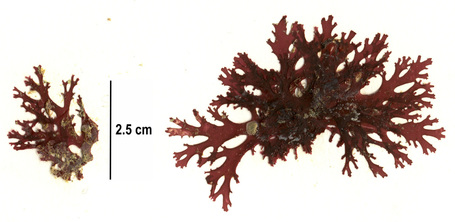Red sea fan • Callophyllis flabellulata
Callophyllis flabellulata specimens from Calvert Island beaches; specimen collection numbers SCL 15338 (left) and SCL 15334 (right) in the UBC Herbarium Algae Database. Images courtesy of Sandra Lindstrom. Search the collection numbers in the database for further details on these specimens, or search this species for additional occurrences.
Identification
Red sea fan species (Callophyllis spp.) are flattened, fan-shaped red algae with veinless, dichotomously-branched blades. Branch width and length varies with species, though such characteristics are generally not enough to accurately differentiate between species. Confirmation at even the genus level may require microscopic examination. See the AlgaeBase Callophyllis page for genus identification details, and see the AlgaeBase species page for more photos.
Mature C. flabellulata plants tend to be no more than 10 cm tall, have irregular to pinnate branching, and the tips of the branches are usually notched.
Habitat & Range
Red sea fan species mostly grow in the subtidal to depths of 20 m, though they may occasionally be found in the low intertidal. They are mostly perennial, and grow on rock, other algae (epiphytic), and animals (epizoic). They are found from northern Alaska to northern Mexico. C. flabellulata is one of the more common species in the genus.
Similar Species
Frilly red ribbon (Palmaria callophylloides), a similar red alga, grows in the high to mid-intertidal.
iNaturalist
https://www.inaturalist.org/taxa/446885-Callophyllis-flabellulata
Red sea fan species (Callophyllis spp.) are flattened, fan-shaped red algae with veinless, dichotomously-branched blades. Branch width and length varies with species, though such characteristics are generally not enough to accurately differentiate between species. Confirmation at even the genus level may require microscopic examination. See the AlgaeBase Callophyllis page for genus identification details, and see the AlgaeBase species page for more photos.
Mature C. flabellulata plants tend to be no more than 10 cm tall, have irregular to pinnate branching, and the tips of the branches are usually notched.
Habitat & Range
Red sea fan species mostly grow in the subtidal to depths of 20 m, though they may occasionally be found in the low intertidal. They are mostly perennial, and grow on rock, other algae (epiphytic), and animals (epizoic). They are found from northern Alaska to northern Mexico. C. flabellulata is one of the more common species in the genus.
Similar Species
Frilly red ribbon (Palmaria callophylloides), a similar red alga, grows in the high to mid-intertidal.
iNaturalist
https://www.inaturalist.org/taxa/446885-Callophyllis-flabellulata
References
Gabrielson, Paul W., Thomas Benjamin Widdowson, and Sandra C. Lindstrom. Keys to the seaweeds and seagrasses of southeast Alaska, British Columbia, Washington, and Oregon. No. 8. University of British Columbia, 2012.
Lamb, A., and Hanby, B. (2005). Marine Life of the Pacific Northwest [electronic version]. Madeira Park, BC: Harbour Publishing.
Lindberg, M. and Lindstrom, S. (2010). Callophyllis spp. Red Sea Fan. Seaweeds of Alaska. Accessed 01/04/2015.
Authors and editors of page
Kelly Fretwell and Brian Starzomski (2015).
Gabrielson, Paul W., Thomas Benjamin Widdowson, and Sandra C. Lindstrom. Keys to the seaweeds and seagrasses of southeast Alaska, British Columbia, Washington, and Oregon. No. 8. University of British Columbia, 2012.
Lamb, A., and Hanby, B. (2005). Marine Life of the Pacific Northwest [electronic version]. Madeira Park, BC: Harbour Publishing.
Lindberg, M. and Lindstrom, S. (2010). Callophyllis spp. Red Sea Fan. Seaweeds of Alaska. Accessed 01/04/2015.
Authors and editors of page
Kelly Fretwell and Brian Starzomski (2015).






